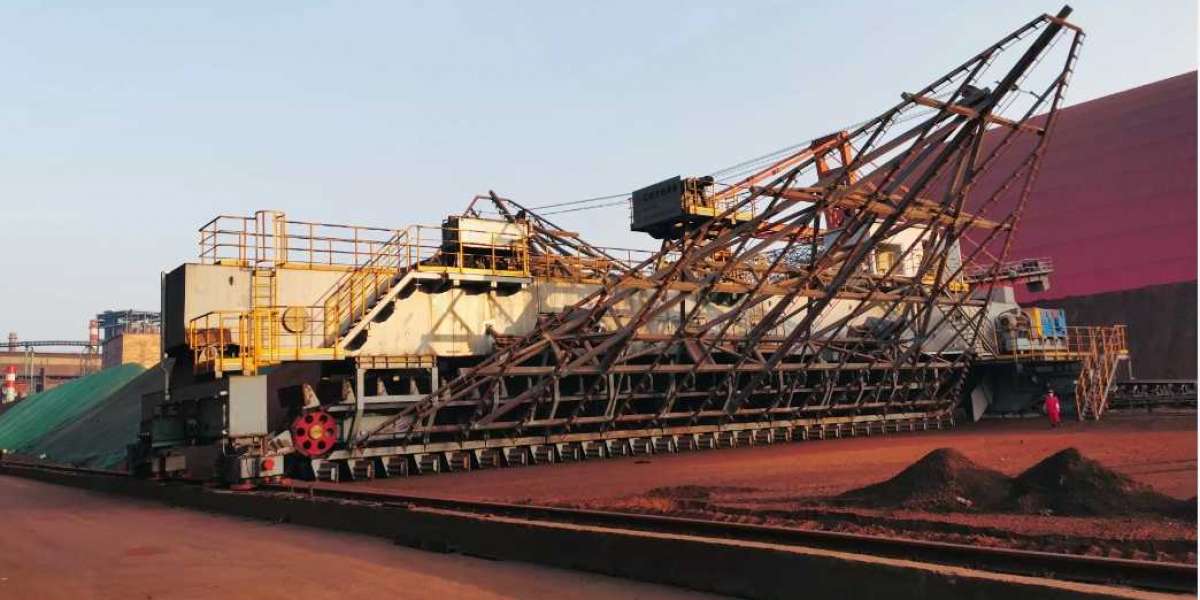Understanding Bridge-Type Scraper Reclaimers
Operation Principles
Bridge-type scraper reclaimers are designed to efficiently reclaim bulk materials such as coal, ore, and various minerals. They operate by traveling on a track located along the top of a stockpile or storage area. The scraper chain with buckets or blades collects material from the pile and discharges it onto a belt conveyor for further transportation.
Key Components
The main components of a bridge-type scraper reclaimer include the bridge, which spans the storage area, and the scraper chain that runs along the length of the bridge. The scraper chain is equipped with buckets or blades that dig into the material, allowing for efficient reclaiming. There are drive units that power the movement of the reclaimer along the track and control systems that ensure smooth operation.
Advantages:
1.Efficient in handling large volumes of materials.
2.Suitable for reclaiming materials with varying particle sizes.
3.Minimizes dust generation during material handling processes.
Maintenance Practices
Proper maintenance is crucial to ensure the longevity and efficiency of bridge-type scraper reclaimers. Regular inspections of components such as the scraper chain, drive units, and control systems are essential to identify any signs of wear or potential issues. Scheduled lubrication of moving parts helps prevent friction-related problems and ensures smooth operation.
Applications in Industries
Bridge-type scraper reclaimers find applications in industries such as mining, cement production, and power generation. In mining operations, they are used to reclaim ores from stockpiles for further processing. In cement plants, these reclaimers handle raw materials like limestone and clay. Power plants utilize them for efficient handling of coal for energy generation.
Key Features of Bridge-Type Scraper Reclaimers
Main Components
Bridge-type scraper reclaimers consist of booms, scraper chains, and buckets. The booms are the structural components that support the entire system, while the scraper chains and buckets work together to scrape material from the stockyard's face.
Importance of Automation
Automation plays a crucial role in bridge-type scraper reclaimers by enhancing efficiency and reducing manual labor. Automated systems ensure precise movement and operation, leading to optimized stockyard management.
Capacity and Speed Variations
Different models of bridge-type scraper reclaimers offer varying capacities and speeds based on the specific requirements of each stockyard. Larger models can handle higher volumes of material at faster speeds, improving overall productivity.
- Pros: Efficient material handling, automated operation, reduced manual labor.
Applications of Bridge-Type Scraper Reclaimers
Industries
Bridge-type scraper reclaimers find extensive applications in industries dealing with bulk materials. Sectors such as mining, power generation, and cement production heavily rely on these machines for efficient material handling.
Efficiency Improvement
The utilization of bridge-type scrapers significantly enhances the efficiency of stockpile management. By automating the process of reclaiming materials from parallel storage piles, these machines streamline operations, reducing manual labor and minimizing downtime.
In various industrial settings worldwide, bridge-type scraper reclaimers have proven their worth through successful implementation. For instance, at the Port of Vancouver in Canada, a bridge-type scraper reclaimer system was installed to handle coal efficiently. This project showcased how these machines can effectively manage large stockpiles while ensuring a continuous flow of materials for shipping.
At the same time, in the iron ore industry in Brazil, major mining companies have integrated bridge-type scraper reclaimers into their operations. These machines play a crucial role in optimizing material handling processes, enabling swift and organized retrieval of ores from storage piles.
Considerations for Selecting a Bridge-Type Scraper Reclaimer
Size Comparison
When choosing a bridge-type scraper reclaimer, one crucial factor to consider is the size. Different models come in various sizes, catering to different capacities and space requirements. Smaller units are suitable for handling moderate volumes of raw materials, while larger ones are ideal for heavy-duty operations.
Configuration Options
The market offers a range of configurations for bridge-type scrapers, each designed to meet specific operational needs. Some configurations include single-sided reclaiming, double-sided reclaiming, and portal scrapers. Understanding the differences between these options is essential to select the most efficient solution for your facility.
Customization Benefits
Customization plays a significant role in optimizing the performance of a bridge-type scraper reclaimer. Tailoring the equipment to suit the unique requirements of your operation can enhance efficiency and productivity. Whether it's adjusting the height, width, or reach of the machine, customization ensures seamless integration into your existing setup.
Maintenance and Troubleshooting of Bridge-Type Scraper Reclaimers
Maintenance Schedule
Regular service is crucial for ensuring the optimal performance of bridge-type scraper reclaimers. A well-planned maintenance schedule should include daily, weekly, monthly, and annual checks. Daily inspections involve checking for any abnormal noises or vibrations during operation. Weekly tasks may include examining the wear on conveyor belts and chains.
Importance of Inspections and Lubrication
Frequent inspections play a vital role in preventing major breakdowns. Face reclamation operations can be disrupted if issues are not detected early. Proper lubrication of moving parts is essential to reduce friction and prevent premature wear. Lubricants should be applied as per the manufacturer's recommendations to maintain efficiency.
Common Maintenance Issues and Solutions
One common issue with bridge-type scrapers is conveyor belt misalignment, leading to uneven material distribution on storage piles. This can be rectified by adjusting the belt tension and alignment. Another prevalent problem is chain breakage due to excessive stress or lack of lubrication. Regularly inspecting chains for signs of wear and tear can help prevent this issue.
1.Belt misalignment
2.Chain breakage
Closing Thoughts
In conclusion, understanding the functionality, features, applications, selection criteria, and maintenance of bridge-type scraper reclaimers is crucial for industries relying on bulk material handling systems. By grasping these aspects, operators can optimize their reclaimer's performance, enhance efficiency, and prolong its lifespan. Adhering to proper maintenance practices and promptly addressing any troubleshooting issues can significantly reduce downtime and operational costs. For those considering investing in a bridge-type scraper reclaimer, thorough evaluation of their specific needs and operational requirements is paramount to selecting the most suitable equipment.
For further insights into bridge-type scraper reclaimers or assistance in optimizing their utilization within your industry, consulting with experts or attending relevant workshops can provide valuable knowledge and guidance. Stay informed about advancements in reclaiming technology to ensure your operations remain competitive and efficient. Continuous learning and adaptation are key to staying ahead in the dynamic landscape of bulk material handling.







